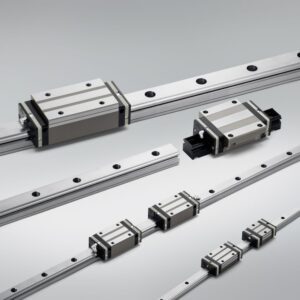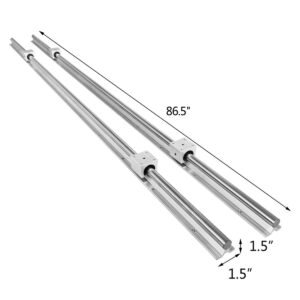Outline
| Headings & Subheadings | LSI / Related Keywords |
|---|---|
| Introduction to Linear Rail Systems | linear motion technology |
| What Are Linear Rail Systems | linear guide rails, motion carriages |
| Key Components of Linear Rail Systems | rail, block, rolling elements |
| How Linear Rail Systems Work | rolling contact, motion precision |
| Advantages of Linear Rail Systems | rigidity, accuracy, low friction |
| Types of Linear Rail Systems | ball-type, roller-type, miniature |
| Linear Rail Systems vs Traditional Bearings | friction and wear comparison |
| Design and Construction Features | hardened steel, stainless steel |
| Linear Rail Systems for CNC Machines | machining precision, repeatability |
| Applications of Linear Rail Systems | robotics, automation, packaging |
| Heavy-Duty Linear Rail Systems | industrial-grade solutions |
| How to Choose the Right Linear Rail System | load, environment, mounting |
| Installation and Maintenance | lubrication, alignment, cleaning |
| Troubleshooting Linear Rail Systems | vibration, noise, wear issues |
| YH Linear: Trusted Linear Rail Systems Manufacturer | OEM, quality, global service |
| Future Innovations in Linear Rail Systems | IoT, smart motion, self-lubrication |
| Sustainability and Eco Manufacturing | recyclable materials, green design |
| Global Market Overview | THK, HIWIN, YH Linear |
| FAQs | lifespan, replacement, lubrication |
| Conclusion | innovation, performance, reliability |
Introduction to Linear Rail Systems
In the evolving world of precision engineering and automation, linear rail systems have become fundamental components that drive accurate, controlled motion. These rails ensure smooth, reliable movement in a straight line — critical for applications like CNC machining, robotics, 3D printing, and medical equipment.
Designed to replace traditional slide mechanisms, linear rail systems enable high-speed, low-friction performance while maintaining excellent rigidity and load capacity. Their introduction revolutionized industrial automation, allowing machinery to achieve micron-level accuracy consistently.
What Are Linear Rail Systems
A linear rail system is a precision motion mechanism composed of a rail and a carriage that uses rolling elements to enable smooth, straight-line motion.
The system’s design eliminates the friction and stick-slip commonly seen in sliding bearings. Instead, rolling elements (usually balls or rollers) circulate within the carriage, minimizing energy loss while enhancing accuracy and efficiency.
These systems are widely used in automation and CNC machinery where repeatability, rigidity, and low maintenance are essential.
Key Components of Linear Rail Systems
Every linear rail system consists of several essential parts:
Guide Rail: Provides a hardened track for the carriage.
Carriage (Block): Houses rolling elements and carries the load.
Rolling Elements (Balls or Rollers): Ensure smooth, low-friction motion.
End Caps and Seals: Prevent dirt and debris from entering the system.
Retainers: Keep rolling elements evenly spaced and circulating properly.
The precision and durability of each component determine the overall performance of the linear rail system.
How Linear Rail Systems Work
Linear rail systems operate through rolling contact between the rail and carriage.
As the carriage moves, the rolling elements rotate and recirculate in a continuous loop, allowing for near-frictionless linear motion. This rolling mechanism drastically reduces wear, increases efficiency, and provides smooth operation even under heavy loads.
The result? Consistent precision and longer equipment lifespan.
Advantages of Linear Rail Systems
The benefits of linear rail systems make them indispensable in modern engineering:
Exceptional Precision: Enables micron-level accuracy for high-performance machinery.
High Load Capacity: Handles both radial and moment loads efficiently.
Low Friction: Reduces energy loss and system heat.
High Rigidity: Ensures stability in high-speed applications.
Long Lifespan: Resistant to wear and corrosion.
Low Maintenance: Easy lubrication and cleaning routines.
These advantages make them the go-to choice for industries prioritizing reliability and precision.
Types of Linear Rail Systems
Depending on design and application requirements, linear rail systems come in various types:
Ball-Type Linear Rail Systems: Feature recirculating balls for smooth, precise movement.
Roller-Type Linear Rail Systems: Offer higher rigidity and load capacity using cylindrical rollers.
Miniature Linear Rail Systems: Ideal for compact devices and delicate instruments.
Heavy-Duty Linear Rail Systems: Designed for industrial-grade performance under extreme loads.
Each type caters to specific performance needs in automation and machinery.
Linear Rail Systems vs Traditional Bearings
| Feature | Linear Rail Systems | Traditional Slide Bearings |
|---|---|---|
| Friction | Extremely low (rolling motion) | High (sliding contact) |
| Speed | High | Moderate |
| Accuracy | Micron-level | Limited |
| Maintenance | Minimal | Frequent lubrication |
| Durability | Long service life | Prone to wear |
| Noise | Quiet operation | Higher vibration |
The comparison highlights why linear rail systems outperform traditional designs in efficiency, speed, and reliability.
Design and Construction Features
The superior performance of linear rail systems results from advanced design and high-quality materials:
Material: Hardened bearing steel or stainless steel for corrosion resistance.
Heat Treatment: Improves hardness and fatigue strength.
Precision Grinding: Ensures perfectly flat, smooth raceways.
Surface Coating: Chrome plating or black oxide prevents rust.
Lubrication Grooves: Maintain consistent grease distribution.
Each design feature enhances accuracy and prolongs operational life.
Linear Rail Systems for CNC Machines
CNC machinery depends heavily on linear rail systems to maintain precision and repeatability.
These systems guide the movement of cutting heads, tables, and spindles with minimal resistance. They prevent deflection, reduce vibration, and allow for high-speed machining without sacrificing accuracy.
For modern CNC systems, linear rails are not just components — they’re the foundation of precision.
Applications of Linear Rail Systems
Linear rail systems are used in a wide range of fields:
CNC Machining and Milling Machines
3D Printing and Laser Equipment
Robotics and Automation Lines
Medical and Imaging Devices
Semiconductor Manufacturing
Packaging and Material Handling Systems
Their versatility makes them vital across nearly every precision-driven industry.
Heavy-Duty Linear Rail Systems
When standard systems can’t handle the load, heavy-duty linear rail systems come into play.
These use reinforced rails and larger rolling elements to bear extreme weights while maintaining smooth, precise motion. Ideal for heavy machinery, presses, and industrial automation, they deliver high rigidity and long-term stability under demanding conditions.
How to Choose the Right Linear Rail System
Choosing the right linear rail system depends on multiple factors:
| Selection Factor | Key Consideration |
|---|---|
| Load Rating | Must match operational forces and moments |
| Precision Grade | Determines motion accuracy |
| Speed & Acceleration | Affects smoothness and noise |
| Operating Environment | Choose corrosion-resistant materials if needed |
| Lubrication Options | Self-lubricating or grease nipples |
| Mounting Type | Side, bottom, or top mount affects rigidity |
Consulting with specialists like YH Linear ensures correct sizing and superior system performance.
Installation and Maintenance
Proper installation and maintenance directly affect the life and accuracy of linear rail systems:
Clean and align mounting surfaces.
Ensure parallelism between rails.
Apply suitable lubricants periodically.
Check preload settings and smooth motion.
Keep rails protected from dust and debris.
Regular inspection guarantees consistent performance and prevents premature wear.
Troubleshooting Linear Rail Systems
Common issues and solutions for linear rail systems:
Noise or Rough Motion: Check for contamination or lack of lubrication.
Uneven Wear: Caused by misalignment or overloading.
Corrosion: Prevent by using stainless steel or protective coatings.
Reduced Accuracy: Re-lubricate or replace damaged rolling elements.
Most problems can be avoided with preventive maintenance and correct installation.
YH Linear: Trusted Linear Rail Systems Manufacturer
YH Linear stands as a reliable supplier of linear rail systems, offering high-precision, durable, and customizable solutions.
Why YH Linear?
Advanced CNC and grinding equipment
ISO-certified manufacturing process
OEM & ODM customization
Strict quality control and testing
Global logistics and after-sales support
Their products deliver superior accuracy, long service life, and exceptional value for industries worldwide.
Future Innovations in Linear Rail Systems
The future of linear rail systems is driven by innovation and digitalization:
Smart Sensors for Predictive Maintenance
Self-Lubricating Carriages
Noise-Reduction Designs
Lightweight Aluminum Components
Integration with IoT and Industry 4.0 Platforms
These advancements enhance automation efficiency while reducing downtime and costs.
Sustainability and Eco Manufacturing
Modern linear rail systems are being designed with sustainability in mind. Manufacturers like YH Linear emphasize:
Use of recyclable steel and eco-lubricants
Waste reduction in machining processes
Energy-efficient heat treatment and coating methods
Long-lasting components to reduce material waste
Such initiatives align with the growing global push toward greener manufacturing.
Global Market Overview
| Brand | Country | Specialty |
|---|---|---|
| YH Linear | China | OEM customization, affordable precision |
| THK | Japan | Industry-leading innovation |
| HIWIN | Taiwan | Versatile product range |
| NSK | Japan | Ultra-precision bearings and guides |
| Bosch Rexroth | Germany | High-performance automation systems |
YH Linear stands proudly among global leaders, offering cost-effective, high-quality alternatives.
FAQs
What are linear rail systems used for?
They provide precise linear motion in CNC machines, automation, and robotics.
Are linear rail systems interchangeable?
Most systems follow international standards, making many components interchangeable.
How long do linear rail systems last?
With proper lubrication and care, they can run for millions of cycles.
Can linear rails handle heavy loads?
Yes, heavy-duty models are specifically designed for such applications.
What type of lubrication is best?
Lithium or synthetic grease is recommended, depending on usage conditions.
Conclusion
Linear rail systems are at the core of modern precision motion, offering unmatched accuracy, strength, and smoothness. From small automation setups to heavy industrial machines, these systems ensure reliable, consistent performance.
With innovation, craftsmanship, and quality assurance, YH Linear continues to lead the way in linear motion technology — helping industries worldwide move with precision and confidence.




